Chilingarian G.V. et al. Surface Operations in Petroleum Production, II
Подождите немного. Документ загружается.

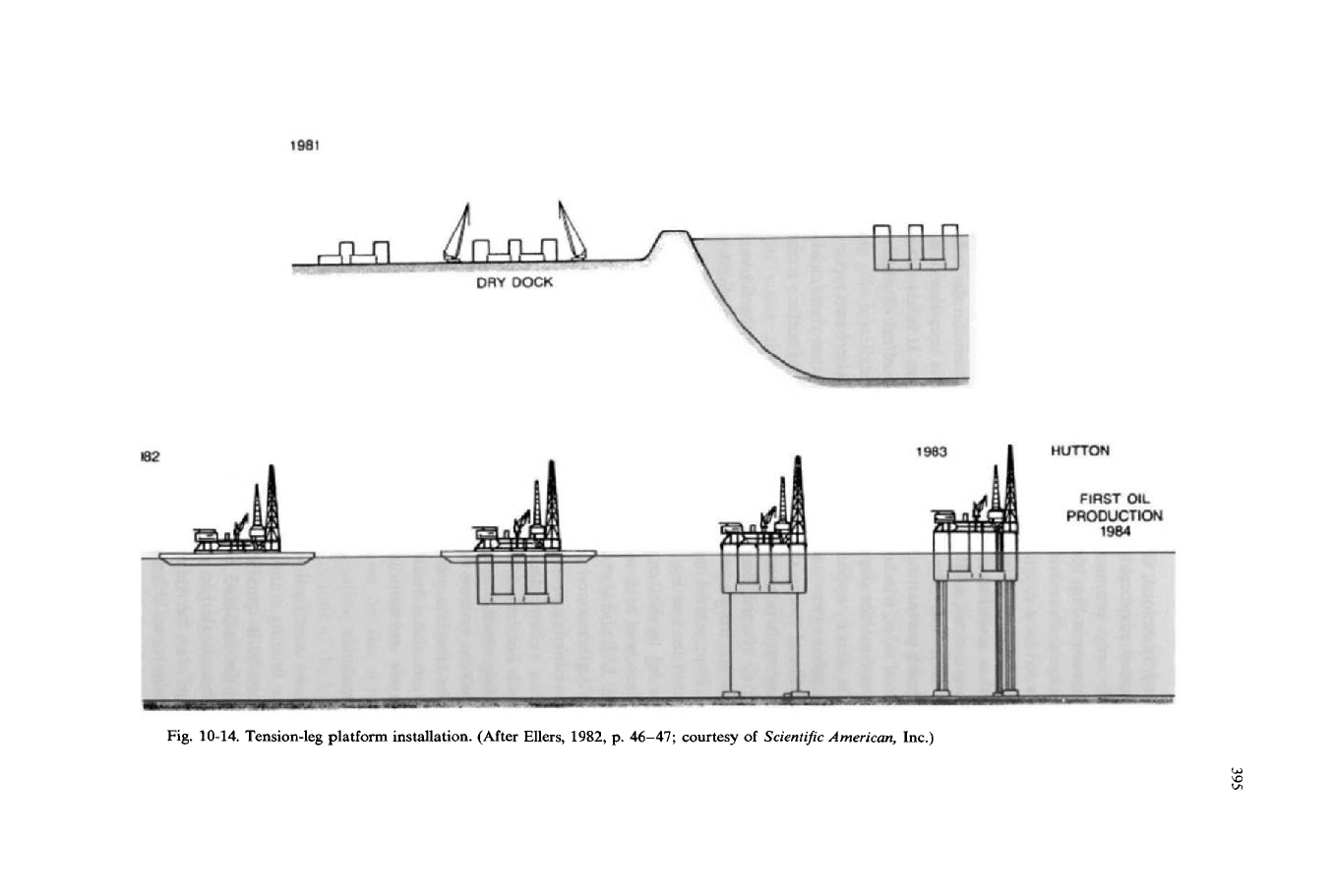
Fig.
10-14.
Tension-leg platform installation. (After Ellers,
1982,
p.
46-47;
courtesy of
Scientific
American,
Inc.)
W
W
wl
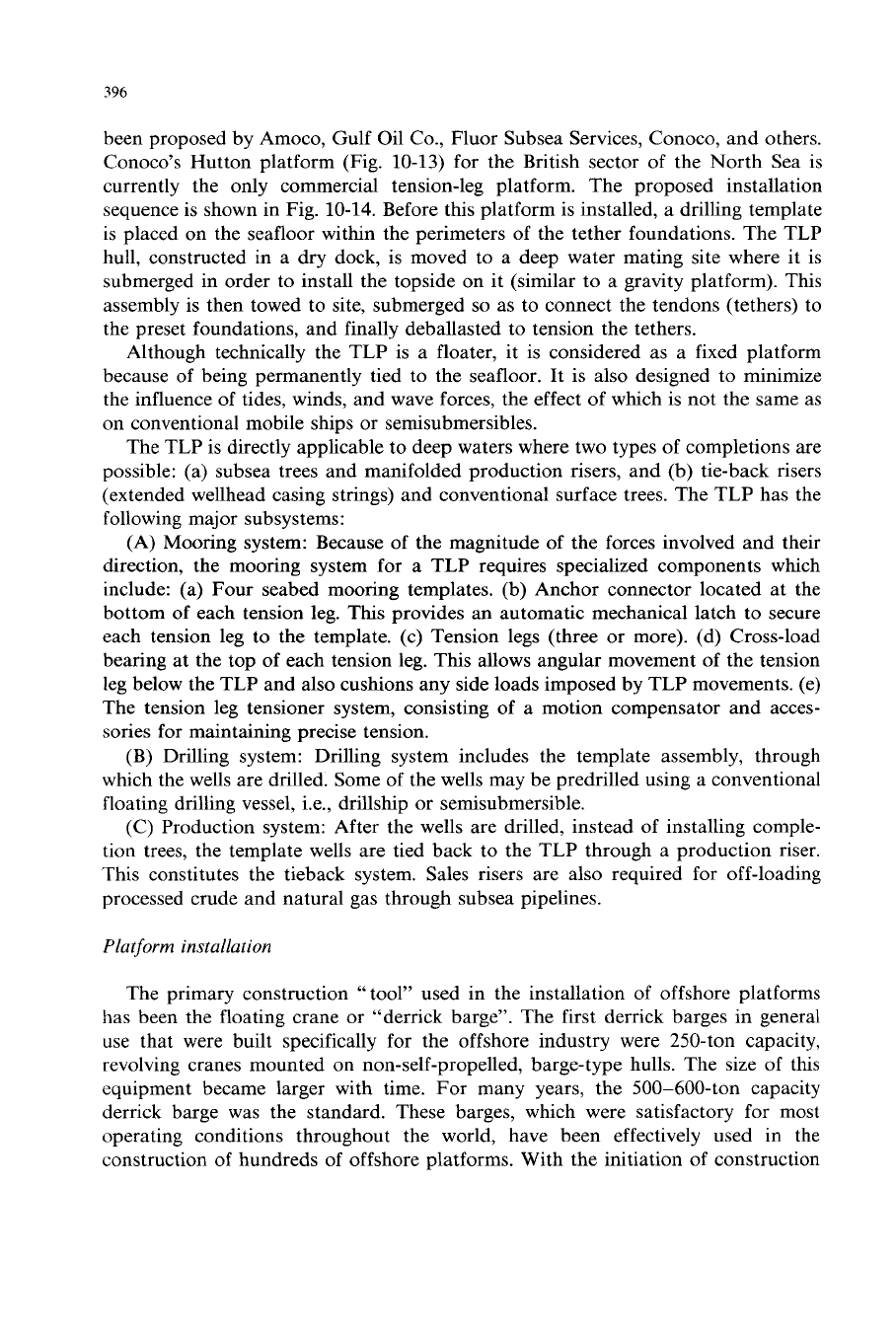
396
been proposed by Amoco, Gulf Oil Co., Fluor Subsea Services, Conoco, and others.
Conoco’s Hutton platform (Fig.
10-13)
for the British sector of the North Sea is
currently the only commercial tension-leg platform. The proposed installation
sequence is shown in Fig.
10-14.
Before this platform is installed, a drilling template
is placed on the seafloor within the perimeters of the tether foundations. The TLP
hull, constructed in a dry dock, is moved to a deep water mating site where it is
submerged in order to install the topside on it (similar to a gravity platform). This
assembly is then towed to site, submerged
so
as
to
connect the tendons (tethers) to
the preset foundations, and finally deballasted to tension the tethers.
Although technically the TLP is a floater, it is considered as a fixed platform
because of being permanently tied to the seafloor. It is also designed to minimize
the influence of tides, winds, and wave forces, the effect
of
whch is not the same as
on conventional mobile ships or semisubmersibles.
The TLP is directly applicable to deep waters where two types of completions are
possible: (a) subsea trees and manifolded production risers, and (b) tie-back risers
(extended wellhead casing strings) and conventional surface trees. The TLP has the
following major subsystems:
(A) Mooring system: Because of the magnitude of the forces involved and their
direction, the mooring system for a TLP requires specialized components which
include: (a) Four seabed mooring templates. (b) Anchor connector located at the
bottom of each tension leg.
This
provides an automatic mechanical latch to secure
each tension leg to the template. (c) Tension legs (three or more). (d) Cross-load
bearing at the top of each tension leg. This allows angular movement of the tension
leg below the TLP and also cushions any side loads imposed by TLP movements. (e)
The tension leg tensioner system, consisting of a motion compensator and acces-
sories for maintaining precise tension.
(B) Drilling system: Drilling system includes the template assembly, through
which the wells are drilled. Some of the wells may be predrilled using a conventional
floating drilling vessel, i.e., drillship or semisubmersible.
(C) Production system: After the wells are drilled, instead of installing comple-
tion trees, the template wells are tied back to the TLP through a production riser.
This constitutes the tieback system. Sales risers are also required for off-loading
processed crude and natural gas through subsea pipelines.
Platform
installation
The primary construction
“
tool” used in the installation of offshore platforms
has been the floating crane or “derrick barge”. The first derrick barges in general
use that were built specifically for the offshore industry were 250-ton capacity,
revolving cranes mounted on non-self-propelled, barge-type hulls. The size of this
equipment became larger with time. For many years, the 500-600-ton capacity
derrick barge was the standard. These barges, which were satisfactory for most
operating conditions throughout the world, have been effectively used in the
construction of hundreds of offshore platforms. With the initiation of construction
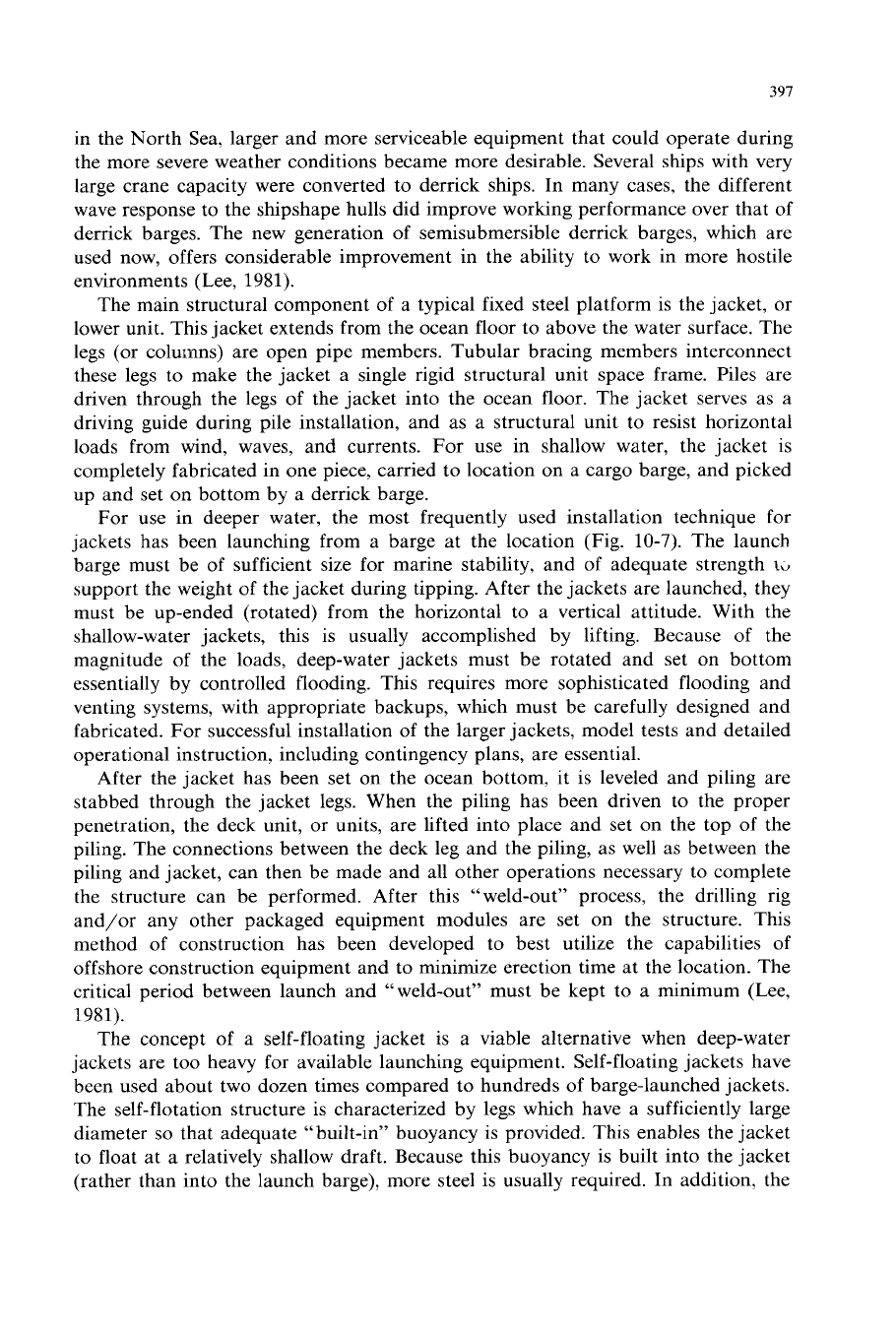
397
in the North Sea, larger and more serviceable equipment that could operate during
the more severe weather conditions became more desirable. Several ships with very
large crane capacity were converted to derrick ships.
In
many cases, the different
wave response to the shipshape hulls did improve working performance over that of
derrick barges. The new generation of semisubmersible derrick barges, which are
used now, offers considerable improvement
in
the ability to work in more hostile
environments (Lee,
1981).
The main structural component of a typical fixed steel platform is the jacket, or
lower unit. This jacket extends from the ocean floor to above the water surface. The
legs (or columns) are open pipe members. Tubular bracing members interconnect
these legs to make the jacket a single rigid structural unit space frame. Piles are
driven through the legs of the jacket into the ocean floor. The jacket serves as a
driving guide during pile installation, and as a structural unit to resist horizontal
loads from wind, waves, and currents. For use in shallow water, the jacket is
completely fabricated in one piece, carried to location
on
a cargo barge, and picked
up and set
on
bottom by a derrick barge.
For use in deeper water, the most frequently used installation technique for
jackets has been launchmg from a barge at the location (Fig.
10-7).
The launch
barge must be of sufficient size for marine stability, and of adequate strength
tu
support the weight of the jacket during tipping. After the jackets are launched, they
must be up-ended (rotated) from the horizontal to a vertical attitude. With the
shallow-water jackets, this is usually accomplished by lifting. Because of the
magnitude of the loads, deep-water jackets must be rotated and set
on
bottom
essentially by controlled flooding. This requires more sophisticated flooding and
venting systems, with appropriate backups, which must be carefully designed and
fabricated. For successful installation of the larger jackets, model tests and detailed
operational instruction, including contingency plans, are essential.
After the jacket has been set
on
the ocean bottom, it is leveled and piling are
stabbed through the jacket legs. When the piling has been driven to the proper
penetration, the deck unit, or units, are lifted into place and set
on
the top of the
piling. The connections between the deck leg and the piling, as well as between the
piling and jacket, can then be made and all other operations necessary to complete
the structure can be performed. After this
“
weld-out’’ process, the drilling rig
and/or any other packaged equipment modules are set
on
the structure. This
method
of
construction has been developed to best utilize the capabilities
of
offshore construction equipment and to minimize erection time at the location. The
critical period between launch and “weld-out’’ must be kept to a minimum (Lee,
1981).
The concept of a self-floating jacket is a viable alternative when deep-water
jackets are too heavy for available launching equipment. Self-floating jackets have
been used about two dozen times compared to hundreds of barge-launched jackets.
The self-flotation structure is characterized by legs which have a sufficiently large
diameter
so
that adequate “built-in” buoyancy is provided. This enables the jacket
to float at a relatively shallow draft. Because this buoyancy is built into the jacket
(rather than into the launch barge), more steel is usually required.
In
addition, the

398
extra wave and current forces
on
the larger legs require increased structural
strength, resulting in heavier framing and, possibly, additional piling. Fabrication of
the larger legs is more complex and, therefore, more expensive. These factors, plus
the additional control system necessary for up-ending and sinking, have tended to
make self-flotation structures more expensive. In some instances, other considera-
tions, such as unavailability of launching equipment or utilization of the large legs
to
protect wells from ice forces, have justified the use of a self-floating platform. It
is
doubtful that a self-flotation jacket has ever been selected purely on the basis of
economics of the structure alone (Lee,
1981).
Platform selection
Selection of the type of platform depends on several factors: (1) The depth of
water,
(2)
sea conditions and environment,
(3)
production life of the wells,
(4)
cost
of the platform system,
(5)
availability of dry docks for launching, and (6) the
distance from the shore. There are other considerations that may determine the
choice.
A
close examination of the features of the various types of platforms reveals
some of these factors.
Figure 10-15 shows the relationship between cost and depth for the common
types of platforms. Decisions are most often based on cost considerations. Projected
water depth capabilities for various platforms are outlined in Fig. 10-16.
Seufloor templates
Templates provide both the guide for drilling operations and a structural base for
the subsea completion equipment (production risers and supports, pipes, valves,
I
I
I I
I
I
GUYED
TOWER
8
LEG
JACKET-
A
~
L
8
2
n
W
_I
1
m
z
-
I00
500
1000
1500
2000
2500
WATER DEPTH,
ft
Fig.
10-15.
A comparison of the design, fabrication, and installation cost of platforms (excluding topside
equipment and facilities) as a function
of
water depth. (After Dunn, 1980, fig.
1,
p.
27;
courtesy of the
National Academy of Sciences.)
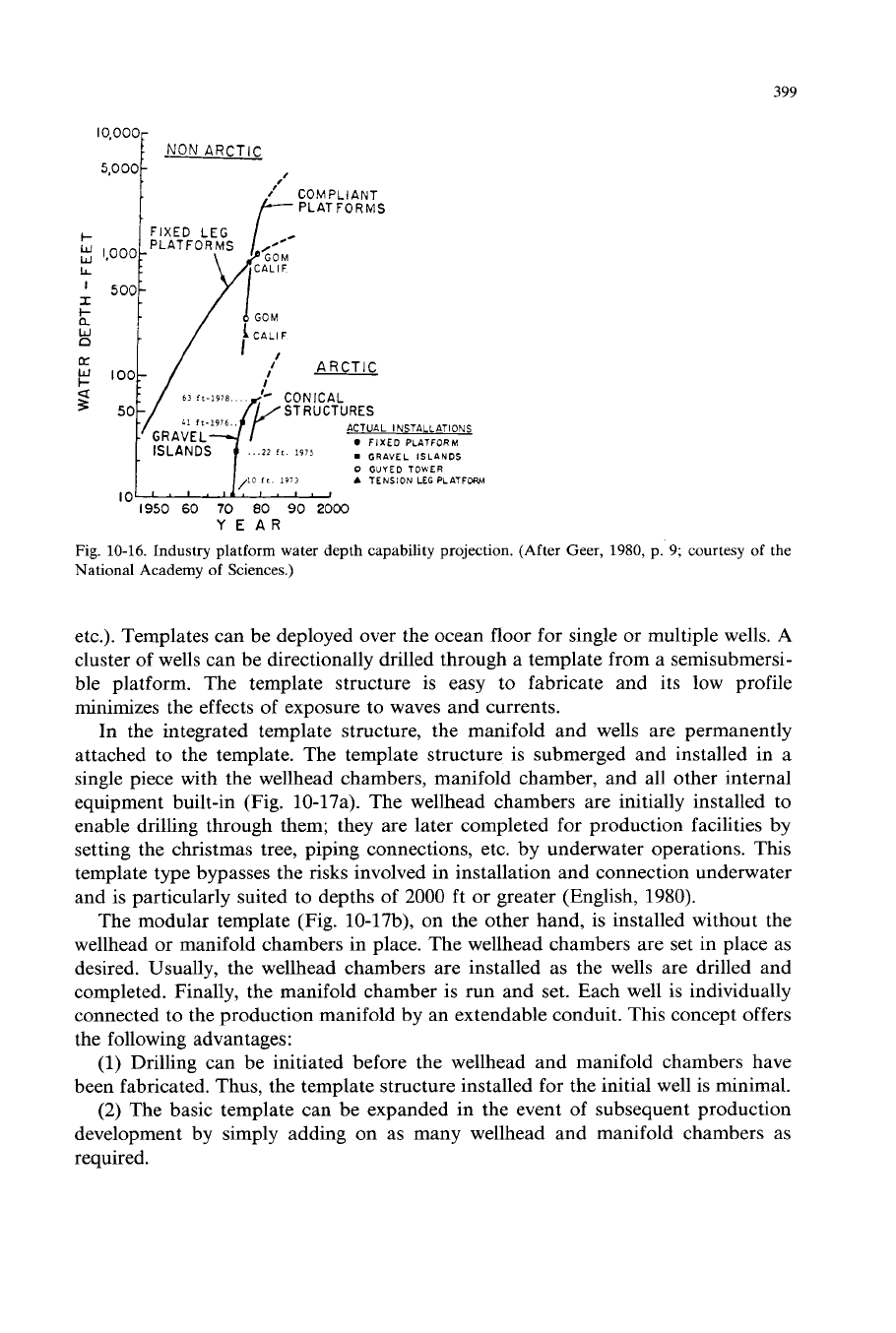
399
NON
ARCTIC
I’
5.000
FIXED
LEG
t-
L
I
i-
W
13
n
U
w
I-
s
‘I
I
ARCTIC
I
CONICAL
STRUCTURES
ACTUAL
INSTALLATIONS
GRAVEL
0
GUYED
TOWER
A
TENSION
LEG PLATFORM
lo
1950
60
10
80
90
2003
YE
AR
Fig.
10-16.
Industry platform water depth capability projection. (After Geer,
1980,
p.
9;
courtesy of the
National Academy of Sciences.)
etc.). Templates can be deployed over the ocean floor for single or multiple wells.
A
cluster of wells can be directionally drilled through a template from a semisubmersi-
ble platform. The template structure is easy to fabricate and its low profile
minimizes the effects of exposure to waves and currents.
In the integrated template structure, the manifold and wells are permanently
attached to the template. The template structure is submerged and installed in a
single piece with the wellhead chambers, manifold chamber, and all other internal
equipment built-in (Fig. 10-17a). The wellhead chambers are initially installed to
enable drilling through them; they are later completed for production facilities by
setting the Christmas tree, piping connections, etc. by underwater operations. Ths
template type bypasses the
risks
involved in installation and connection underwater
and is particularly suited to depths
of
2000
ft or greater (English,
1980).
The modular template (Fig. 10-17b), on the other hand, is installed without the
wellhead or manifold chambers in place. The wellhead chambers are set in place as
desired. Usually, the wellhead chambers are installed as the wells are drilled and
completed. Finally, the manifold chamber is run and set. Each well is individually
connected to the production manifold by an extendable conduit. This concept offers
the following advantages:
(1) Drilling can be initiated before the wellhead and manifold chambers have
been fabricated. Thus, the template structure installed for the initial well is minimal.
(2)
The basic template can be expanded in the event of subsequent production
development by simply adding on as many wellhead and manifold chambers as
required.
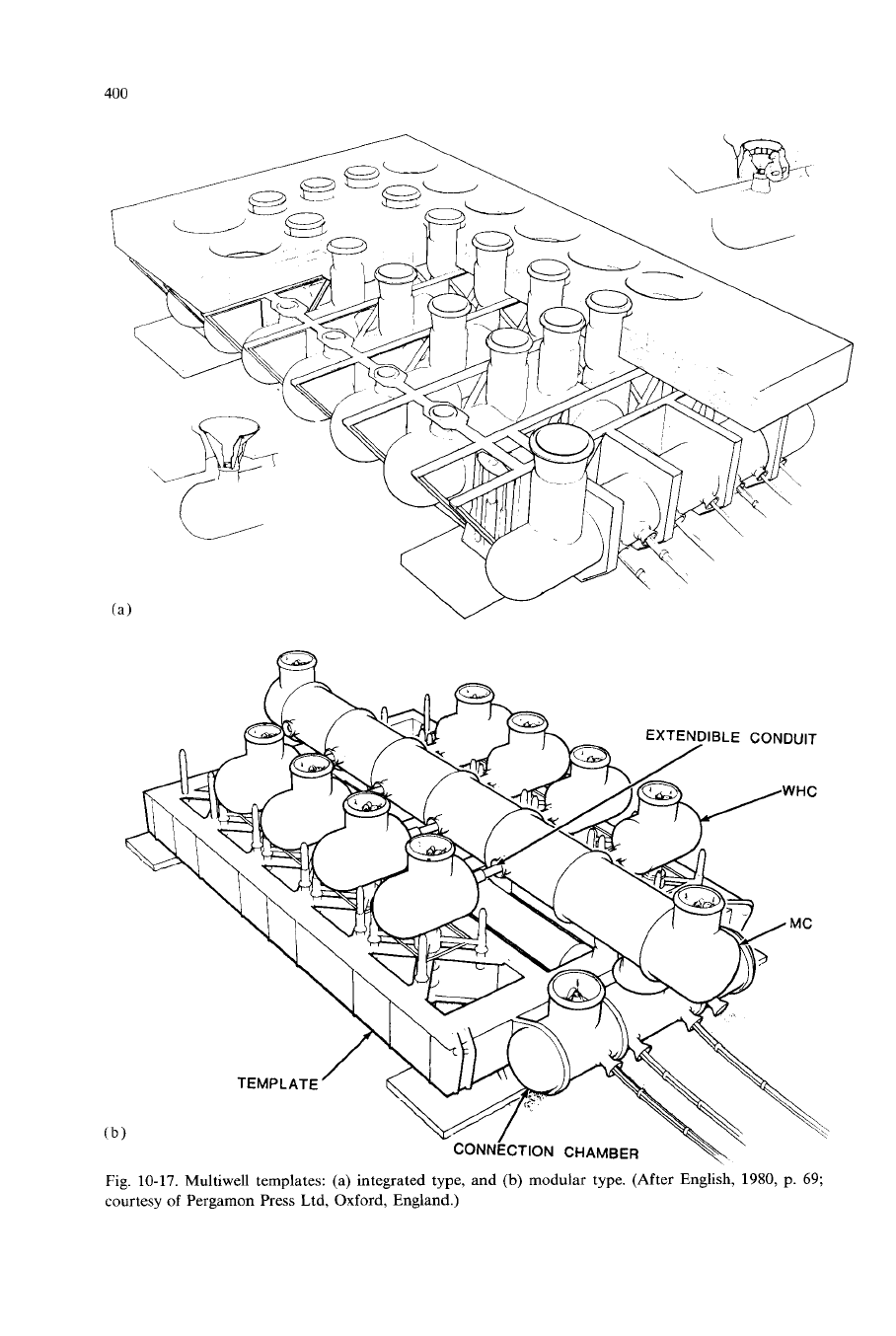
400
Fig. 10-17. Multiwell templates:
(a)
integrated type, and
(b)
modular type. (After English, 1980,
p.
69;
courtesy of Pergamon
Press
Ltd, Oxford, England.)
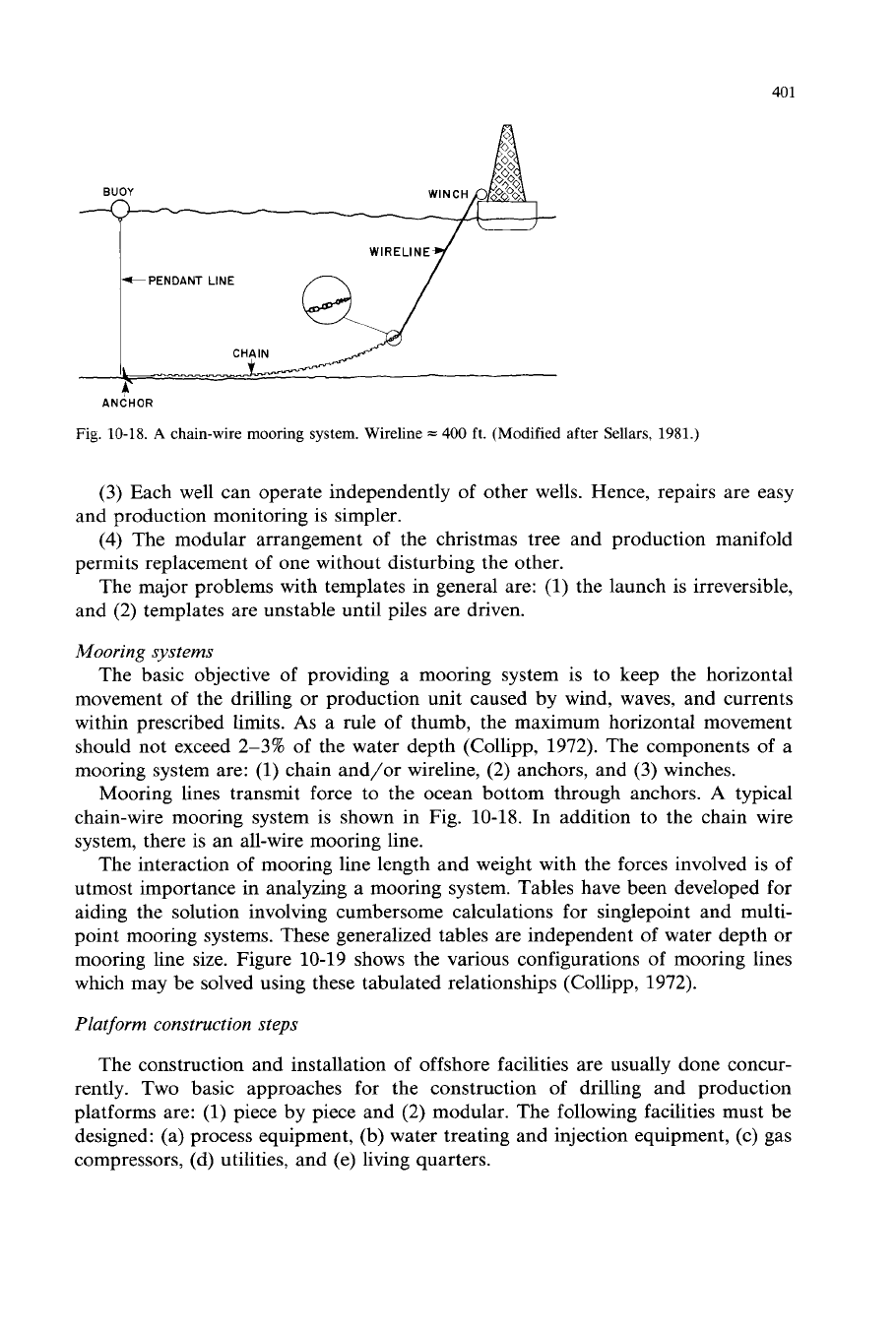
401
+PENDANT
LINE
ANCHOR
Fig.
10-18.
A chain-wire mooring system. Wireline
=
400
ft. (Modified after Sellars,
1981.)
(3) Each well can operate independently of other wells. Hence, repairs are easy
(4)
The modular arrangement of the Christmas tree and production manifold
The major problems with templates in general are: (1) the launch is irreversible,
and production monitoring is simpler.
permits replacement of one without disturbing the other.
and (2) templates are unstable until piles are driven.
Mooring systems
The basic objective of providing a mooring system is to keep the horizontal
movement of the drilling or production unit caused by wind, waves, and currents
within prescribed limits.
As
a rule of thumb, the maximum horizontal movement
should not exceed 2-3% of the water depth (Collipp, 1972). The components of a
mooring system are: (1) chain and/or wireline, (2) anchors, and (3) winches.
Mooring lines transmit force to the ocean bottom through anchors.
A
typical
chain-wire mooring system is shown in Fig. 10-18. In addition to the chain wire
system, there is an all-wire mooring line.
The interaction of mooring line length and weight with the forces involved is of
utmost importance in analyzing a mooring system. Tables have been developed for
aiding the solution involving cumbersome calculations for singlepoint and multi-
point mooring systems. These generalized tables are independent of water depth or
mooring line size. Figure 10-19 shows the various configurations of mooring lines
which may be solved using these tabulated relationships (Collipp, 1972).
Platform construction steps
The construction and installation of offshore facilities are usually done concur-
rently. Two basic approaches for the construction of drilling and production
platforms are: (1) piece by piece and (2) modular. The following facilities must be
designed: (a) process equipment, (b) water treating and injection equipment, (c) gas
compressors, (d) utilities, and (e) living quarters.
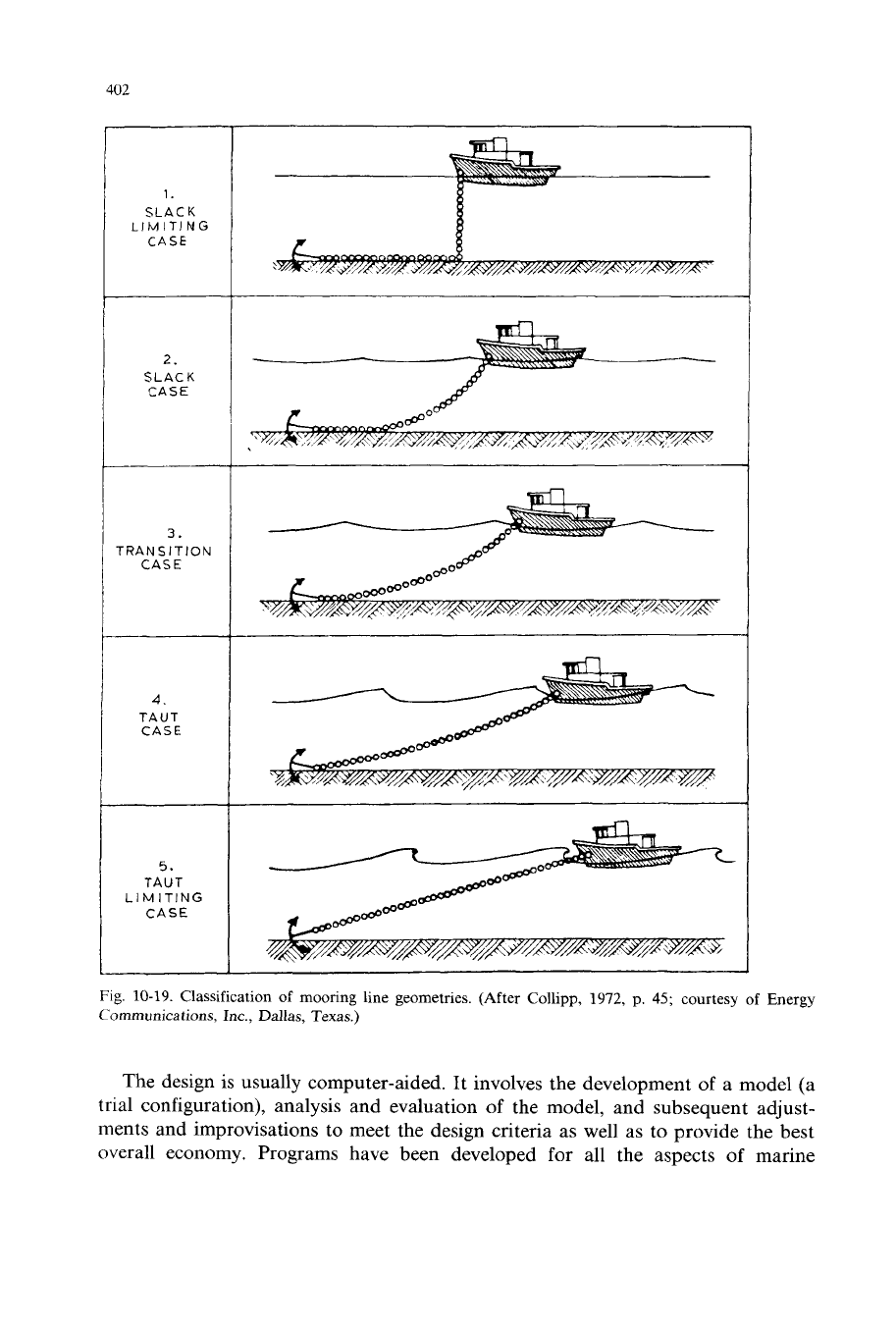
402
1.
SLACK
LIMITING
2.
SLACK
CASE
3.
TRAN SIT
ION
CASE
I
4.
TAUT
CASE
1
5.
TAUT
LI
M
ITlNG
1
CASE
Fig.
10-19.
Classification
of
mooring line geometries. (After Collipp,
1972,
p.
45;
courtesy
of
Energy
Communications,
Inc.,
Dallas,
Texas.)
The design is usually computer-aided. It involves the development
of
a model (a
trial configuration), analysis and evaluation
of
the model, and subsequent adjust-
ments and improvisations to meet the design criteria as well as to provide the best
overall economy. Programs have been developed for all the aspects
of
marine
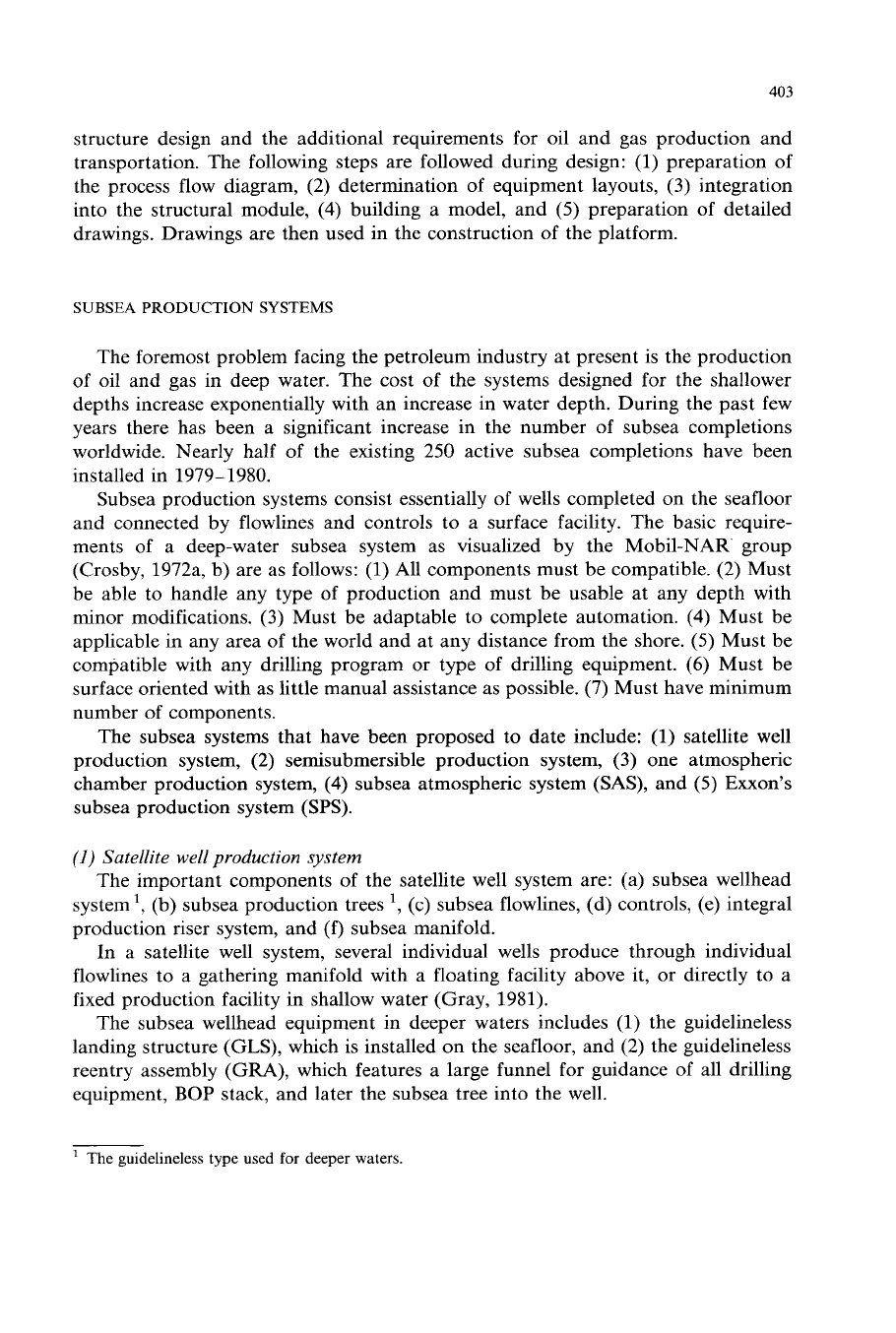
403
structure design and the additional requirements for oil and gas production and
transportation. The following steps are followed during design:
(1)
preparation of
the process flow diagram, (2) determination of equipment layouts,
(3)
integration
into the structural module,
(4)
building a model, and
(5)
preparation of detailed
drawings. Drawings are then used in the construction
of
the platform.
SUBSEA
PRODUCTION
SYSTEMS
The foremost problem facing the petroleum industry at present is the production
of
oil and gas in deep water. The cost
of
the systems designed for the shallower
depths increase exponentially with an increase in water depth. During the past few
years there has been a significant increase in the number of subsea completions
worldwide. Nearly half of the existing 250 active subsea completions have been
installed in 1979-1980.
Subsea production systems consist essentially of wells completed on the seafloor
and connected by flowlines and controls
to
a surface facility. The basic require-
ments of a deep-water subsea system as visualized by the Mobil-NAR group
(Crosby, 1972a, b) are as follows: (1) All components must be compatible.
(2)
Must
be able to handle any type of production and must be usable at any depth with
minor modifications.
(3)
Must be adaptable to complete automation.
(4)
Must be
applicable in any area of the world and at any distance from the shore.
(5)
Must be
compatible with any drilling program or type
of
drilling equipment.
(6)
Must be
surface oriented with as little manual assistance as possible.
(7)
Must have minimum
number of components.
The subsea systems that have been proposed to date include:
(1)
satellite well
production system, (2) semisubmersible production system,
(3)
one atmospheric
chamber production system,
(4)
subsea atmospheric system (SAS), and
(5)
Exxon's
subsea production system
(SPS).
(1)
Satellite well
production
system
The important components
of
the satellite well system are: (a) subsea wellhead
system
',
(b) subsea production trees
',
(c) subsea flowlines, (d) controls, (e) integral
production riser system, and
(f)
subsea manifold.
In a satellite well system, several individual wells produce through individual
flowlines to a gathering manifold with a floating facility above it, or directly to a
fixed production facility in shallow water (Gray, 1981).
The subsea wellhead equipment in deeper waters includes (1) the guidelineless
landing structure (GLS), which is installed on the seafloor, and
(2)
the guidelineless
reentry assembly
(GRA),
which features a large funnel for guidance of all drilling
equipment,
BOP
stack, and later the subsea tree into the well.
The guidelineless type used
for
deeper waters.
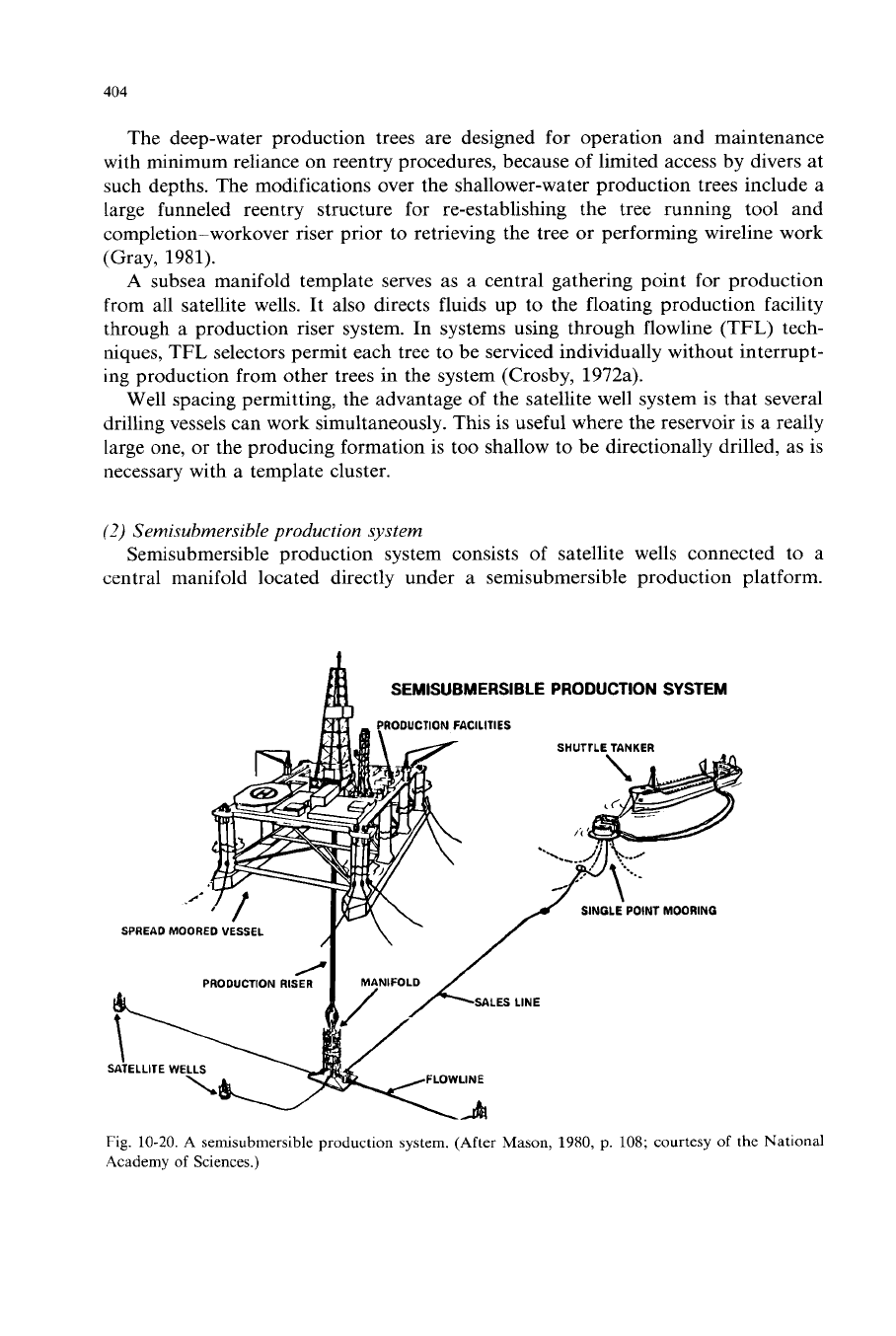
404
The deep-water production trees are designed for operation and maintenance
with minimum reliance on reentry procedures, because of limited access by divers at
such depths. The modifications over the shallower-water production trees include a
large funneled reentry structure for re-establishing the tree running tool and
completion-workover riser prior to retrieving the tree or performing wireline work
(Gray,
1981).
A
subsea manifold template serves as a central gathering point for production
from all satellite wells. It also directs fluids up to the floating production facility
through a production riser system. In systems using through flowline (TFL) tech-
niques, TFL selectors permit each tree to be serviced individually without interrupt-
ing production from other trees in the system (Crosby, 1972a).
Well spacing permitting, the advantage of the satellite well system is that several
drilling vessels can work simultaneously. This is useful where the reservoir is a really
large one, or the producing formation is
too
shallow to be directionally drilled, as is
necessary with a template cluster.
(2)
Semisubmersible production system
Semisubmersible production system consists of satellite wells connected to a
central manifold located directly under a semisubmersible production platform.
SEMISUBMERSIBLE PRODUCTION SYSTEM
PRODUCTION FACILITIES
SHUTrLE
TANKER
. an
Fig.
10-20.
A
semisubmersible production system. (After Mason,
1980,
p.
108;
courtesy
of
the National
Academy
of
Sciences.)
